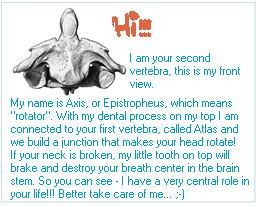|
 |
Possible Effects
The successes of Craniosacral Osteopathy sometimes sound like miracle
healings. This has to do with the possibility of removing the cause of
a disease, and not only a symptom. The causes of the symptoms are
treated, and not the symptoms themselves, which might come back after a
while. Headaches or even Migraine can be healed within a few sessions, instead of using pain
killers for the rest of your life. Even the restart of still standing
processes "under
the surface" can be triggered by sessions in Craniosacral Osteopathy.
Through the connection of body, soul and spirit, these processes bind
energy not only in your soul, but also your body, sometimes leading to
painful injuries.
instead of using pain
killers for the rest of your life. Even the restart of still standing
processes "under
the surface" can be triggered by sessions in Craniosacral Osteopathy.
Through the connection of body, soul and spirit, these processes bind
energy not only in your soul, but also your body, sometimes leading to
painful injuries.
The release of this capetured energy out of your body system sets it
free also in your soul. Sadness may come up, tears may roll during a
session. And with the help of your therapist you can accept and
acknowledge your sadness. And with this, you can let everything (for
example a trauma like the loss of a lover or another very close person)
go.
Craniosacral Osteopathy can be used for loosening constrictions in the
musculosceletal system, motorical limitations, headaches, migraine,
tinnitus, chronical pain syndromes and especially psychological
disorders with expressions in the body system.
The
Name
Craniosacral Osteopathy is based upon a rythm, arising in the third
ventricle of the brain, being forwarded by the cerebrospinal fluid over
the cerebral membranes - especially the Dura Mater - to the bones. This
rythm can easily be perceived by putting hands on the scull or the
sacral bone. The anatomical name for the scull is "Cranium", the one
for the sacral bone is "Os sacrum". Putting them together brought up
the name.
Discovery
and Discoverers
About 100 years ago, William G. Sutherland developed a method for
systematical testings of the bones of the human scull. The effects he
got were that unbelievable, that he was called a mountebank and his
method got forgotten.
Around 1970 John Upledger MD, an American neurosurgeon, recognized
rhythmic movements of the meninx during surgery of a spine tumor, which
were undependend from breath and heartbeat of the patient and had a
frequency of about 8-12 per minute.
Two years later he was one of the participants of a seminar about
Sutherland's ideas and the idea of a hydraulic system within scull and
spine came up immediately.
In 1975 he brought scientist of different disciplines together to the
Michigan State University, to build the scientific background of
Cranial Osteopathy. Later on he founded the Upledger Institute for the
treatment of pain and dysfunction in the Craniosacral System.
Biophysical Basis
Our scull is quite hard, but not immovable like a coconut. It is made
of many bones, connected by connective tissue, called the sutures. The
connective tissue gives the bones the possibility to move against or
with one another. Rhythmic changes of internal pressure in the
hydraulic system using the cerebrospinal fluid, developed by John
Upledger, cause the movements of the bones.
The cerebrospinal fluid can be found in the inner ("Ventricles") and
outer cavities of our brain and spinal chord. It protects our Central
Nervous System against injuries caused by quick movements and feeds it.
The Craniosacral Rhythm
Our Central Nervous System and our cerebrospinal fluid pulse together
in the so called Craniosacral Rhythm (CSR), which can be perceived by
anyone. The rhythm can not be influenced by your will and has a
frequency of 8-12 per minute. Any restrictions by for example
mechanical injuries of the body or psychic trauma have effect on the
quality of the CSR, which can be perceived by the practitioner. By
using a soft touch generally not over 5 grams (the weight of a nickel)
restrictions in the Craniosacral System can be released.
|